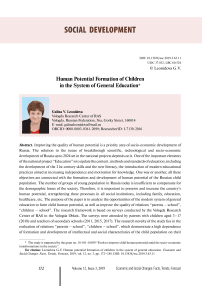Human potential formation of children in the system of general education
Автор: Leonidova Galina V.
Журнал: Economic and Social Changes: Facts, Trends, Forecast @volnc-esc-en
Рубрика: Social development
Статья в выпуске: 3 (63) т.12, 2019 года.
Бесплатный доступ
Improving the quality of human potential is a priority area of socio-economic development of Russia. The solution to the issues of breakthrough scientific, technological and socio-economic development of Russia up to 2024 set in the national projects depends on it. One of the important elements of the national project “Education” is to update the content, methods and standards of education, including the development of the 21st century skills and the new literacy, the introduction of modern educational practices aimed at increasing independence and motivation for knowledge. One way or another, all these objectives are connected with the formation and development of human potential of the Russian child population. The number of groups of young population in Russia today is insufficient to compensate for the demographic losses of the society. Therefore, it is important to preserve and increase the country’s human potential, strengthening these processes in all social institutions, including family, education, healthcare, etc. The purpose of the paper is to analyze the opportunities of the modern system of general education to form child human potential, as well as improve the quality of relations “parents - school”, “children - school”. The research framework is based on surveys conducted by the Vologda Research Center of RAS in the Vologda Oblast. The surveys were attended by parents with children aged 3-17 (2018) and teachers of secondary schools (2011, 2015, 2017). The research novelty of the study lies in the evaluation of relations “parents - school”, “children - school”, which demonstrate a high dependence of formation and development of intellectual and social characteristics of the child population on their quality. Thus, human development rate is higher (0.822 units) among children whose parents are involved in their school life than among the rest, even among those who are not deprived of their parents’ attention (0.786 units - answers: often). The study shows that the less parents and children contact in relation to reading, the lower the indicators of child human potential (with constant reading practice, the rate is 0.840 units, with occasional - 0.781 units.). The research results are useful for experts in education and organizations working with parents of schoolchildren.
Human potential, child population, parents, system of general and supplementary education, interaction of parents and school in child education
Короткий адрес: https://sciup.org/147224178
IDR: 147224178 | УДК: 37.032 | DOI: 10.15838/esc.2019.3.63.11
Текст научной статьи Human potential formation of children in the system of general education
Human development accounts for more than 70% of a country’s national wealth. The main integral measure of human potential is the world’s widely recognized Human Development Index (HDI)1. It is calculated2 annually (since 1990) within the framework of the UN Development Programme and includes a UNDP Human Development Report [1]. Such reports are published today by more than 100 countries (in Russia – since 1997).
In the ranking of countries in 2018, Norway is the leader (0.958 units). Russia [2] ranks 49th (Tab. 1). Despite the fact that the country is in the group with a very high level of human development, the lag behind top five countries is more than 15%. However, the current position of Russia in the ranking is lower than during the Soviet period, where it ranked 31st (0.734 units) in 1990.
Russia, like many countries of the world, seeks to enter the path of sustainable development. Therefore, improving human potential is a priority area of its socioeconomic development. The importance of human potential is emphasized in all strategic documents of the Russian Government and program speeches of the Russian President who
Table 1. Performance of integral UNDP HDI
|
Country |
1990 |
2000 |
2010 |
2015 |
2017 |
2018 |
|
Norway |
0.850/3* |
0.917 |
0.942 |
0.948 |
0.953 |
0.958/1 |
|
Germany |
0.801/12 |
0.868 |
0.921 |
0.933 |
0.936 |
0.936/5 |
|
USA |
0.860/2 |
0.885 |
0.014 |
0.920 |
0.924 |
0.924/14 |
|
Japan |
0.816/9 |
0.855 |
0.885 |
0.905 |
0.909 |
0.909/19 |
|
France |
0.779/20 |
0.849 |
0.882 |
0.898 |
0.901 |
0.901/24 |
|
Poland |
0.712/44 |
0.785 |
0.835 |
0.835 |
0.865 |
0.865/33 |
|
Russia |
0.734/31 |
0.720 |
0.780 |
0.813 |
0.813 |
0.816/49 |
|
Belarus |
- |
0.683 |
0.792 |
0.805 |
0.808 |
0.811/53 |
|
Brazil |
0.611/80 |
0.684 |
0.724 |
0.757 |
0.759 |
0.759/79 |
|
China |
0.502/102 |
0.594 |
0.706 |
0.743 |
0.762 |
0.762/90 |
|
India |
0.427/113 |
0.493 |
0.581 |
0.627 |
0.640 |
0.640/130 |
* Hereinafter – country’s position in the ranking.
Source: Data from the official website of the UN Development Programme. Available at: has repeatedly stressed that “ of our main competitive advantages ... is efficient use of people’s knowledge and skills” [3]. The national projects approved in 2019 also reflect an action plan which aims to improve the human potential in Russia. It includes four projects (“Healthcare”, “Education”, “Demography”, “Culture”) with a total funding of more than five trillion rubles [4]. One of the goals of the project “Education” reads: “The education of a harmoniously developed and socially responsible person based on spiritual and moral values of the peoples of the Russian Federation, historical and national and cultural traditions”.
The accumulation of human potential begins in the childhood. “It is the state of the child population, its socio-biological characteristics that is the basis for the formation of human potential and human capital in the modern society” [5].
The main institutional environment necessary for the formation of the qualitative human potential of the child population is primarily the family, as well as educational institutions that are included from a child’s certain age in the process of socialization of their personality.
Education is a complex social phenomenon, the sphere of transfer, assimilation and processing of knowledge and social experience, which ensures the importance of this sphere for human development.
The purpose of the article is to analyze the possibilities of the modern system of general education for the formation of human potential of children, as well as the quality of relations “parents – school”, “children – school”.
The main approaches to studying human potential of the child population
A great interest in human potential is caused primarily by the conditions of increasing global competition for this resource [6]. Many works of domestic and foreign scientists are devoted to the analysis of the nature of the concept under study. The evolution of theories of human development is associated with the works of economists such as A. Smith [7], D. Ricardo, J.M. Keynes, Th. Schumpeter, A. Marshall [8], T. Veblen, T. Schultz [9], G. Becker [10], K. Marx, and W. Petty. They present ideas and conclusions about the place of a human in the structure of national wealth, its role in intellectual activity, investing in its development. Further development of the theoretical provisions is aimed at a narrower category of “human capital”, which is considered as a result of investment and a source of human income in the future. Later, the “concept of human development” (A. Sen [11], M. ul Haq [12]) became widespread, which became the basis of [13] Human Development reports [14].
There are differences in terminology in Russian and foreign studies of human development. The representatives of the socio-demographic school of thought (N.M. Rimashevskaya et al.) note that the term “human potential” whihch ahs gained a foothold in Russia “is substantially more accurate” [15, p. 83], “in contrast to the term “human development” adopted abroad”. The analysis of the category “human potential” in the works of domestic researchers shows that the most used components of human potential [16] are intellectual, creative, communicationbased, value-based, and activity. Moreover, the greatest number of characteristics that form the basis of human potential assessment is presented in the theory of population quality initiated by N.M. Rimashevskaya. A distinctive feature of her socio-demographic school is the study of human (or population) potential in aspects such as health (physical, mental, social); professional and educational abilities (intellectual potential), cultural and moral behavior (socio-cultural activity).
This approach is used in the analysis of child’s human potential [17]. The difference from the “adult” human potential is that child’s potential is evaluated from the standpoint of formation of certain skills taking into account the age-specific development:
-
1) in terms of health – physical skills, hygiene, diet and rest, mental state, stress resistance, etc.;
-
2) intellectual development (skills that characterize the formation of higher mental functions: memory, thinking, imagination, attention, including digital skills);
-
3) socio-cultural activity (skills of children’s socio-cultural adaptation – etiquette and communication, household behavior, etc.).
It is noteworthy that in scientific literature the concept of “child human potential” is not present despite the fact that its active formation takes place in childhood with the participation of main institutions: family, system of education and healthcare.
Child population is more often studied in categories such as health, mental development, and social adaptation. There are no comprehensive studies assessing child human potential in general. From this point of view, the research undertaken by the researchers of the Vologda Research Center of RAS under the Russian Foundation for Fundamental research grant is unique and original.
In this article we focus on one of the social institutions that form child potential – the system of general education.
The approach to “education as one of the leading social institutions” was proclaimed by psychologists (L.S. Vygotskii, A.N. Leontiev, A.R. Luria), economists (D. North, M. Weber, S.G. Kirdina, T. Luckmann, G. Spencer, S.G. Strumilin), sociologists (G.E. Zborowskii,
F.E. Sheregi, D.L. Konstantinovskii, and G.A. Cherednichenko), as well as the representatives of other social sciences. In our study, we consider education from the point of view of the institutional theory, since “... the development of education ... is determined by the institutional characteristics of the society” [18]. Education as an institution performs a specific set of functions focused on certain social needs:
-
– transfer (translation) of knowledge from generation to generation;
-
– generation and preservation of culture of the society;
-
– socialization of an individual and their integration into society;
-
– promotion of reproduction and change of the social structure of the society, the channel of individual social mobility;
-
– social control [19].
In the scientific literature, the main functions of education are considered more widely: as a range of socio-cultural, socioeconomic and socio-political positions. The first group includes objectives aimed at the development of spiritual life of the society, preservation, transfer and development of the cultural heritage. Socio-economic functions are associated with the formation and development of intellectual, scientific, technological and human potential, as well as social stratification. The implementation of socio-political functions ensures social security in its broadest sense [20].
An educational system, as defined by F. Sheregi, is “a basic social institution that determines the level of scientific, technological, economic and cultural progress of the society” [21]. At the same time, education is considered from the standpoint of formation of an individual in all its manifestations and qualities. “In the end, the highest value and hierarchically highest goal of education is mental characteristics of both personality and the society in their natural interrelation and interdependence” [22]. The latter is the subject of the research analysis – the relations and interdependence of three actors affecting the formation of human potential, i.e. sociocultural, intellectual characteristics of the child population – parents, children and education.
Materials and research methods
The informational framework of the research is based on the results of a sociological survey among the population of the Vologda Oblast. Empirical data were collected in 2018 in the form of a handout survey of parents. 1,500 people with children aged 3–17 in the cities of Vologda and Cherepovets, in Babaevskii, Velikoustyugskii, Mezhdurechenskii, Gryazo-vetskii, Kirillovskii, Nikolskii, Tarnogskii and Sheksninskii districts were surveyed. The sample was represented on the basis of statistics on the age and sex composition of the population in the Vologda Oblast as of 01.01.2017, it was ensured by the proportions between urban and rural population, between the inhabitants of settlements of various types (rural settlements, small and medium cities); the age structure of child population in the region.
The data on social well-being and financial situation of teachers of secondary schools in the Vologda Oblast obtained from the monitoring study conducted by the Vologda Research center of RAS in 2011, 2015, 2017, and a pilot survey of parents of school children in Vologda (2018) are partially used.
To analyze certain aspects of child human development, Rosstat statistics databases are used, along with sources of foreign databases, the results of sociological studies of the Higher School of Economics (HSE) and the Russian Presidential Academy of National Economy and Public Administration (RANEPA) on the relevant topics.
Results and discussion
One of the central issues of modern general education is motivation for learning activities. Motivating factors are critical in achieving positive learning results. The researchers note a wide variety of motives that affect the effectiveness of training, which is primarily due to age characteristics [23]. There are two clusters of educational motives: cognitive interests associated with the need to master skills and knowledge, and broad social motives as a response to the need for communication, evaluation and approval of other people, the desire to take a certain place in the system of public relations [24]. Parents of school children evaluate these groups of motives as equivalent, on average by 3.9 points on a 5-point scale ( Tab. 2 ). The requirements to personal development of children have increased significantly with the introduction of new federal state educational standards. This is especially evident in increased attention to students’ personal qualities such as activity, independence, initiative . The importance of development of these qualities is emphasized and introduced in the national project “Education” by the indicator of social
Table 2. Parents’ assessment of importance of educational motives for children on a 5-point scale, average points
|
Educational motives |
Average points |
|
Personal (a sense of self-esteem and ambition, desire for authority among peers) |
4.0 |
|
Social (awareness of the social significance of learning, understanding the value of learning as something developing personality, the need to develop worldview and mindset, etc.).) |
3.9 |
|
Cognitive (interest in obtaining knowledge, curiosity, desire to develop cognitive skills, getting pleasure from intellectual activity, etc.).) |
3.9 |
|
Source: data of opinion survey of students’ parents, VolRC RAS, 2018. |
|
Figure 1. Parents’ assessment of degree of children’s volitional qualities, average points on a 5-point scale
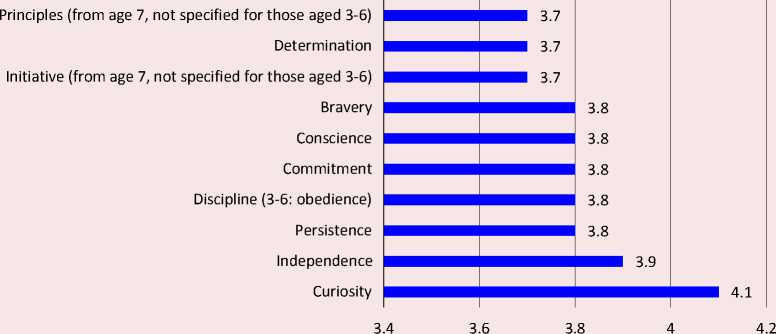
Source: data of opinion survey of students’ parents, VolRC RAS, 2018.
activity of students “ number of students involved in activities of public associations on the basis of educational institutions of general education, secondary and higher professional education ”, which is expected to increase 8 times in 2024 (from 1.61 to 8.8 million people) [4].
Independence as one of the volitional qualities of an individual is estimated by parents quite high – 3.9 points out of 5. However, this is not the highest score. The most developed quality of children, according to their parents, is curiosity (above 4 points; Fig. 1 ). Qualities such as perseverance, discipline, commitment, conscience, and courage is rated 3.8 by the respondents. Initiative is developed to a lesser extent (3.7 points), and this gives a pause for thought. Moreover, this characteristic is not predominant not only in the average sample, but also among older age groups (11–14 and 15–17).
Motivation to educational activity largely depends on the child’s attitude to educational institutions (kindergarten, school, professional institutions), the quality of the relations “children – school”. The formation of human potential of the child population in educational institutions should be accompanied by a comfortable external environment which determines children’s mood at school. The research shows that in general, the positive attitude prevails among school children (Tab. 3): more than a third of parents (36%) say that their child has a positive attitude to school. Another 46% of children have a friendly attitude to school, though sometimes it depends on the mood. The most positive attitude is among children from Cherepovets, according to estimates of their parents (48%).
The least positive attitude towards school is typical for school children in rural areas. This does not appear to be a random assessment. It is known that the optimization of the social sphere that took place in the recent past affected the rural infrastructure (in total, during 1990–2016, the school network in the region was reduced by more than 2 times – from 835 to 366 units [25]). Increased distance between the place of residence and the place of education, including school, began to be positioned as the main causes of migration
Table 3. Parents’ assessment of their children’s attitude to school (for parents with children aged 3–6 the question concerned kindergarten attendance), %
The problems of formation of human potential of the child population in rural areas is reflected in the index calculated by the researchers [11] of VolRC RAS based on the data from the sociological survey4 ( Fig. 2 ). It shows the development of basic characteristics of a child personality, which together form the potential that generate the basis of the future of human potential.
Figure 2 shows that the index of human potential development of the child population (IHPDC) among rural children in the districts (0.768 units) is substantially lower than the corresponding values of potential among urban children (0.827 units in Vologda and 0.799 units in Cherepovets). Moreover, the index value is lower than the average regional indicator (0.792 units).
Parent involvement in the child’s school life , the family’s interest in their education is an essential condition for qualitative formation of human potential.
The study shows that only a quarter of parents (26%) always stay with the child when they do their homework. Almost as many (28%) do it often, but not always. And the rest of parents admit that it happens rarely, from time to time or never (45.8%).
However, the survey results show that constant parents’ attention to this issue has a positive impact on the development of child human potential ( Tab. 4 ). Among those children whose parents demonstrate great attention to their children’s school life the rate of human potential formation is higher (0.822 units) than among the rest, even those who are not deprived of their parents’ attention (0.786 units – often). Indicators of intellectual development (memory, attention, thinking and other characteristics) are also significantly higher (0.810 units). Accordingly, their parent asses the thinking skills of a child to be higher – 4.1.
It is noteworthy that parents may not always be able to help their child in understanding any complex school tasks. According to sociologists, “innovations in education significantly complicate qualitative performance of parents as translators of educational skills to their
Figure 2. Index of human potential development of the child population in the Vologda Oblast by age (parents’ assessment), points
0.84
0.83
0.82
0.81
0.8
0.79
0.78
0.77
0.76
0.75
0.74
0.73
0.792
Vologda Oblast
0.827
Vologda
0.799
Cherepovets
0.768

Districts
Source: opinion survey of students’ parents, VolRC RAS, 2018. [11]
Another significant problem of interaction between parents and children is learning to read or reading together. Reading books “expands children’s understanding of the world, develops thinking, teaches perseverance and develops skills of independent work, analysis, forms worldview, values, and beliefs” [28].
Cross-country studies of children’s learning achievements (e.g., PIRLS) conducted by international organizations (in this case, the International Association for the Evaluation of Educational Achievement) help assess the level of reader’s literacy, compare the quality of reading and understanding of texts by primary school students in different countries. Russia has participated in all waves of PIRLS research conducted since 2001 (once every five years). Russian school children demonstrate good results: in 2016 they ranked 1st (Fig. 3).
Developed countries are currently discussing the problem of “reading crisis”, believing that its consequences could have a negative impact on the economic, social and spiritual life of the society in the future [30]. The study confirms these concerns.
Table 5 suggests the less parents and children contact with regard to reading, the lower the indicators of human potential formation of children (with constant reading practice, the index is 0.840 units, with very rare – 0.781 units, in the absence of such practice – 0.759
Figure 3. Russia’s position in international student research [29]
|
TIMSS — 2015 |
PISA —2015 PIRLS —2016 |
|
thematics 4th grade: 7th among 49 iiiiiiiiiiiiiiiiiiiiiiiiiiniiiiiiiiiii thematics 8th grade: 6th among 39 iiiiiiiiiiiiiiiiiiiiiiiiiiiii |
Mathematics: 20–30th among 70 iiiiiiiiiiiiiiiiiii|||||iiiiiiiiiiiiiiiiiiiiiiiiiiiiiiiiiiiiiiii |
|
ence 4th grade: 4th among 47 iiiiiiiiiiiiiiiiiiiniiiiiiiiiiiiiiii ence 8th grade: 7th among 39 iiiiiiiiiiiiiiiiiiiiiiiiiiiii |
Science: 30–34th among 70 IIIIIIIIIIIIIIIIIIIIHMIIIII||||lllllllllllllliaiMMI>llllllll |
|
vanced Mathematics: 1st l ■ IIIIIIIMMIIIIIIIIIIIII |
Reading: 19–30th among 70 Reading: 1st among 50 llllllllllllllllll|||||||||llllllllllllllllllllllllllllllllllllllll |lllllllllllllllllllllllllllllllllllllllllllllllll |
Table 5. Dependence of human potential formation of child population on the quality of relations “parents – children” in terms of reading together, %
Thus, the quality of relations “parents – children” highly affects the formation of human potential of children. And it not only the process of joint action that is important, but also parents’ attention, their involvement in their children’s life. According to the research of Public Opinion Foundation, modern parents note “a high demand for close relations with children... But in order to build relations one you needs to spend time with children. 42% believe that they spend less time with children than they would like to” [31].
An important factor in the development of human potential of the child population is participation in supplementary education programs. In 2018, within the framework of the priority project on supplementary education in Russia, a model of personalized financing of supplementary education was implemented. In the Vologda region by the end of 2017, more than 15,000 children received certificates for supplementary education services. An increased coverage of children aged 5–18 with supplementary educational programs (2016 – 694 units, 2015 – 489 units, 2014 – 112 units) has ensured the implementation of the 2012 May Decree of the President of the Russian Federation [32]. The Decree is expected to increase the coverage of children aged 5–18 with supplementary education programs to 70–75% by 2020. The target value of the national project “Education” to participate in supplementary education programs – 80% by 2024 [4].
Figure 4. Distribution of parents’ answers to question “Does your child attend supplementary education classes (courses)?”, %
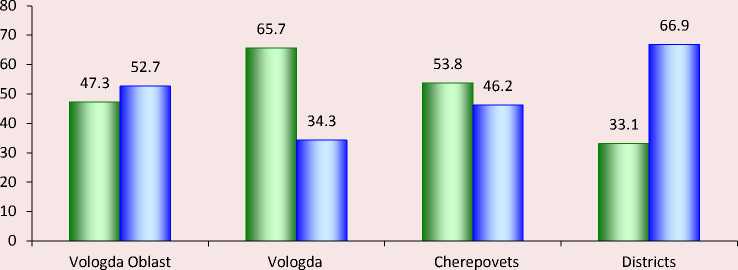
□ Yes □ No
Source: opinion survey of students’ parents, VolRC RAS, 2018.
According to the research, most urban children have access to supplementary education. 66% of Vologda and 54% of Cherepovets parents note that their child/ children attend classes of supplementary education ( Fig. 4 ).
At the same time, only one third of rural children (33%) have access to this type of educational (creative, search, entertaining, developing) activity. This situation significantly limits the conditions for qualitative formation of children’s human potential in rural areas.
A very important research result is the identification of motives of parents who decide that their children need to receive supplementary educational services ( Tab. 6 ). According to the survey, the focus on child’s interests and hobbies is the most preferable among the parent community (4.5 points on a 5-point scale). This position ranks first according to the survey results. The second is child’s abilities and aptitude (4.4). It can be argued that this approach will provide the child with conscious professional choice, and a job by vocation in the future. This is very important for the economy of any territory (district, region, country).
The researchers have proved that a job by vocation gives a significant economic effect, which is expressed in greater returns on wage, higher quality of workers and their increased productivity compared to the rest of employees [33].
The leading role of the child’s wish when choosing supplementary education institutions is demonstrated by the results of HSE studies showing that about half of parents (42.5%) state their child’s wish to be the reason for choosing a particular course [34]. Thus, the relations “children – school” demonstrate a positive trend in the sphere of supplementary additional. This is especially important because more than 70% of 15–17-year-old children, according to their parents, have already chosen their future profession ( Tab. 7 ). Such confidence is inherent in both urban and rural parents almost equally.
The analysis of prevalence of supplementary education for children shows that the most common areas are art (59%) and sports (57%). The same areas of supplementary education can be found in parents’ responses about their education (58% and 43%, respectively). The
Table 6. Assessment of significance of motives which influence parents’ decision that their child should attend supplementary education courses (% of those whose child attends courses of supplementary education; answer “Yes”), average score on a 5-point scale
|
Option |
Vologda |
Cherepovets |
Districts |
Oblast |
|
Child’s interests and hobbies |
4.6 |
4.3 |
4.4 |
4.5 |
|
Child’s abilities and aptitude |
4.5 |
4.3 |
4.3 |
4.4 |
|
Parents’ wish |
3.8 |
3.6 |
3.4 |
3.6 |
|
Affordable cost of the service |
3.8 |
3.6 |
3.3 |
3.6 |
|
Prospects and relevance of this sphere |
3.6 |
3.5 |
3.5 |
3.5 |
|
Recommendations of friends, acquaintances |
3.1 |
3.3 |
3.2 |
3.2 |
|
“Fashion” for this type of supplementary education |
2.4 |
2.8 |
2.8 |
2.7 |
|
Source: opinion survey of students’ parents, VolRC RAS, 2018. |
Table 7. Distribution of parents’ answers to question “Has your child decided on the choice of future profession? (question for parents of children aged 15–17), %
The prevalence supplementary classes of different profile for children varies in federal districts of Russia ( Fig. 5 ).
For example, sports are more popular among children in the South, North Caucasus, Ural federal districts and the Republic of Crimea, art-related classes – in the North West, Volga and Far East federal districts. The Far East Federal District is also characterized by tourism and handicraft programs. Technology classes are most often attended by children of the Volga Federal District, and smallest number of children of this profile is in the Siberian and Ural Federal districts.
It is interesting to trace the effectiveness of classes of supplementary education ( Fig. 6 ). Most parents note that their child’s engagement in supplementary education has significantly affected the development of their creative potential (65%). Moreover, the child’s contacts have expanded (55%) and their intellectual level has significantly increased (51%).
It is estimated that more than a third of parents note that the level of leadership skills of the child becomes significantly higher (38%) as they attend supplementary education classes. This is a significant result which shows that lack of attention to the development of children’s initiative at school is compensated for in the system of supplementary education.
It is noteworthy that, according to the estimates of the parent community, both cognitive and social motives of children’s educational activities are implemented in
Figure 5. Prevalence of supplementary education profiles for children in federal districts (FD) of Russia, 2017 (% of the total number of parents who responded) [34, p. 21]
Science (research in natural sciences, humanities, social sciences, economics, regional studies)
Art (fine arts, applied arts, dance, music, theatre)
Technology (design, modeling etc.)
Sports and physical education
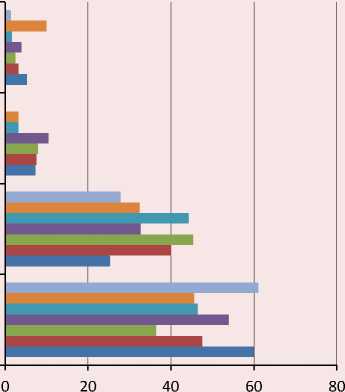
■ Far East FD
■ Siberian FD
■ Ural FD
■ Volga FD
South FD, North ■ Caucasian FD,
Crimea FD
■ Central FD
■ Northwestern FD
the system of general and supplementary education with a certain degree of success. Accordingly, the formation of components of human potential of the child population such as intellectual and socio-cultural development is ensured.
One of the factors directly affecting IHPDC in terms of development of abilities, knowledge, and skills is the quality of a professional teaching group and, accordingly, the quality of relations “parents – school”, “children – school”.
The main criteria of socio-professional status of teachers are the level of education and qualifications. The results of the TALIS-2018 research show that 75% of Russian teachers have been trained in specialist’s and master’s programs, every sixth (16%) received a bachelor’s degree5 (Fig. 7). In the countries participating in the TALIS study, these figures are lower – 41% (master’s degree) and 51% (bachelor’s degree), respectively.
Judging by the data of RANEPA study (2013–2014), the first qualification category (49% of teachers) is the most common among teachers, 31% of teachers have higher qualification category [36].
The growing shortage of teachers, which is a feature of the modern stage of education development, significantly complicates the process of developing child human potential. The coverage of teachers of general education in Russia in the 2016/2017 academic year was 96.6%, while in 2015/2016 academic year – 99.2% [37]. The most sought-after in Russian schools are teachers of foreign languages (coverage in Russian schools – 96.2%), Mathematics – 95.8%, PE– 95.6%. The schools’ need for qualified specialists is very acute, which can be traced by the example of the Vologda Oblast [37]. According to the Department of Labor and Employment of the
Figure 6. Distribution of parents’ answers to question “What results have supplementary classes brought?”, % of those whose children attend classes of supplementary education (answer “Yes”)
|
70 |
64.8 |
||||||
|
60 50.8 |
55.1 |
||||||
|
50 40 |
37.6 |
||||||
|
30 |
24.9 |
||||||
|
20 7.6 9.4 |
12.3 |
||||||
|
10 10 0.8 |
|||||||
|
I I |
|||||||
|
|||||||
Source: opinion survey of students’ parents, VolRC RAS, 2018.
Figure 7. Level of teachers’ formal education, %
Russia
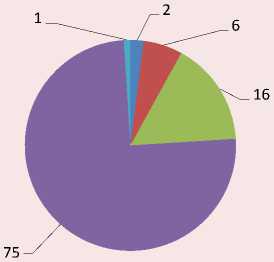
TALIS-18
-
■ lower than secondary vocational education
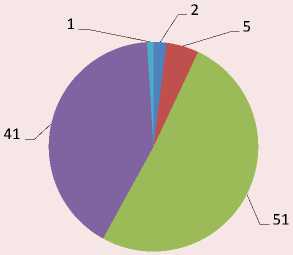
-
■ Secondary
vocational education
-
■ Bachelor's degree
-
■ Specialist's and
Master's degree
-
■ Postgraduate and higher
Source: Lifelong education of teachers and school principals: report on the results of the international teachers study on teaching and learning TALIS-2018 (Teaching and learning international survey). Part 1. Moscow: Rosobrnadzor, 2019. 41 p.
Figure 8. Coverage of teachers at educational institutions in the Vologda Oblast
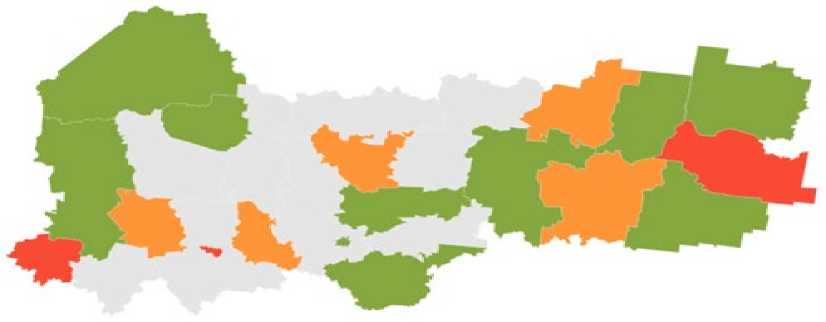
- Balanced staff number of vacancies and applicants is the same): Babaevskii district Vashkinskii district Vytegorskii district Gryazovetskii district
Nikolskii district Nyuksenskii district Totemskii district
Velikoustyugkii district
Sokolskii district Vologda
- Slight staff shortage (number of vacancies slightly exceeds the number of applicants):
Babushkinskii district Kaduiskii district
- Moderate staff shortage (number of vacancies exceeds the number of applicants):
Kich-Gorodetskii district Chagodoshchenskii district Cherepovets



Tarnogskii district Kharovskii district Sheksninskii district
Source: Employment barometer. Available at: (accessed: 06.05.2019).
Vologda Oblast, a moderate shortage of teaching staff is observed in Chagodoshchenskii, Kichmengsko-Gorodetskii districts and in the city of Cherepovets ( Fig. 8 ). A slight shortage is indicated in Babushkinskii, Kaduyskii, Tarnogskii, Kharovskii and Sheksninskii districts [37]. As of the beginning of May 2019, there are 34 vacant jobs for teachers of foreign language, 17 – for Physics and Mathematics teachers, 8 – for primary school teachers in the region6.
The quality of teaching staff is directly related to the quality of the parent–school relations. The results of a three-wave monitoring study of social well-being and financial situation of teachers at secondary schools in the Vologda Oblast conducted by VolRC RAS (in 2011, 2015 and 2017) demonstrate [25] the teachers’ satisfaction with the relations with children (satisfaction index7 – 185 points) and children’s parents (166 points) within their teaching activity. Similar assessment is repeated in the parent environment. At the same time, parents demonstrate a higher level of satisfaction than teachers. The highest index values in the estimates of parents are those reflecting the professionalism of the teaching staff (194 points) and teachers’ attitude towards children (179 points)8.
Conclusion
The framework of human potential is formed primarily in the family and the educational system as key social institutions. The contribution of other factors (healthcare, culture) is definitely undeniable, yet knowledge and skills that help a person create their “capital”, belong to the first two sustainable forms of people’s organization. However, family and educational sphere, being the most important social institutions for the formation of child human potential, have a number of determining characteristics. The research reveals that greater success in formation of child human potential is achieved by families who pay much more attention to their children’s education and are more involved in their school life. Studies have shown that there are certain problems in the “parents – school” relations within the framework of “parents – children” relations. These include, in particular, insufficient parents’ involvement in their children’s school life, which is a limiting factor in the process of human development. Accordingly, this problem should be addressed by the teachers to improve their cooperation with the parent community, primarily through improving the quality of education, increasing access to information about children’s school life, assistance in mastering the skills of efficient parenthood, increasing parents’ participation in the school life (discussion of the school development program, content and methods of education, ways to achieve indicators, etc.). However, parents should strive to interact with teachers, realizing that their participation in the school life of their children should not be limited to its material content. It is necessary to shift the focus to spiritual and moral communication. After all, it is parents that the right message should go from, determining children’s motivation and interest in learning.
A number of characteristics of child human potential is successfully formed in the system of supplementary education. However, the share of children involved in engineering classes is insufficient, which will affect the country’s lag in this process in the digitalization era. To increase attention to children’s involvement in engineering classes within supplementary education it is especially necessary to interact with the parent community.
There are significant limits for child human development in rural areas. The study shows a significant gap in IHPDC of rural areas. It is necessary to pay attention to the conditions of formation of human potential of rural children – increasing the availability of educational resources, including online forms of supplementary education. We believe that target support for rural schools as a tool for equalizing social opportunities is also necessary.
The analysis of the quality of interaction between the triad of actors (parents, children, school) and its role in the formation of human potential of the child population made it possible to justify a new approach to modeling/ building these relations. Our approach is based on shifting the relations from the “chain” model (parents – children – school) towards the “circle” model (parents – children – school – parents), in which actors can effectively build child potential.
As a result of implementing this approach, the interaction between the school and parents should be raised to a new level. First of all, in terms of parents’ understanding of their responsibility for their children’s education and upbringing. The meaning of effective cooperation should lie in establishing symmetrical mutually beneficial relations between teaching and parenthood [38], which will make a significant contribution to the formation and development of child human potential.
Список литературы Human potential formation of children in the system of general education
- Chelovecheskoe razvitie dlya vsekh i kazhdogo: doklad o chelovecheskom razvitii. 2016 [Human Development for Everyone. Human Development Report 2016]. Washington: Communications Development Incorporated, 2017. 40 p.
- Human Development Indicators. Available at: http://hdr.undp.org/en/media/hdr (accessed: 05.06.2018).
- Poslanie Prezidenta RF Federal'nomu sobraniyu, 01.03.2018 g. [Presidential Address to the Federal Assembly. 01.03.2018]. Available at: http://www.kremlin.ru/acts/bank/42902
- Natsional'nye proekty: klyuchevye tseli i ozhidaemye rezul'taty, 07.02.2019 g. [National Projects" Key Objectives and Expected Outcomes]. Available at: http://government.ru/projects/selection/741/35675
- Rimashevskaya N.M. Child population in Russia: main problems of development. Ekonomicheskie i sotsial'nye peremeny: fakty, tendentsii, prognoz=Economic and Social Changes: Facts, Trends, Forecast, 2011, no. 1 (13), pp. 59-70. (In Russian).
- Ivanov O.I. Chelovecheskii potentsial (formirovanie, razvitie, ispol'zovanie) [Human Potential (Formation, Development, Application)]. Saint Peersburg: Skifiya-print, 2013. 336 p.
- Smith A. An Inquiry into the Nature and Causes of the Wealth of Nations. Moscow: Eksmo Publisher, 2007.
- Marshall A. Principles of Political Economy. Moscow: Progress Publisher, 1983, vol. 1.
- Shultz T. Human Capital in the International Encyclopedia of the Social Sciences. New York, 1968, vol. 6.
- Becker G.S. Human Capital. New York: Columbia University Press, 1964
- Sen A. Resources, Values and Development, 1997.
- Fukuda-Parr S., Shi-va Kuma K.A. (Eds.). ul Haq M. The Human Development Paradigm. Readings in Human Development. Oxford, UK: Oxford University Press, 2003, pp. 17-34.
- Kolesov V.P. (Ed.). Chelovecheskoe razvitie: novoe izmerenie sotsial'no-ekonomicheskogo progressa: uch. posobie [Human Development: the New Dimension of Socio-economic Progress: study guide]. 2nd edition. Moscow: Prava cheloveka, 2008. 636 p. Available at: undp.ru›nhdr2008/undp_uchebnik_site.pdf. (accessed: 02.05.2019).
- Human Development Report 1990. UNDP. New York: Oxford University Press, 1990. 180 p.
- Rimashevskaya N.M., Bochkareva V.K., Migranova L.A., Molchanova E.V., Toksanbaeva M.S. Human potential of Russian regions. Narodonaselenie=Population, 2013, no. 3, pp. 82-140. (In Russian).
- Rossoshanskaya E.A., Ustinova K.A., Likhacheva T.N. Theoretical and methodological approaches to human potential research of rural areas. Problemy razvitiya territorii=Problems of Territory's Development, 2017, no. 4(90), pp. 96-111. Available at: http://pdt.vscc.ac.ru/article/2302. (In Russian).
- Korolenko A.V., Gordievskaya A.N. Human potential of the child population: understanding and assessment. Sotsial'noe prostranstvo=Social Area, 2018, no. 5(17). 5.17.3. (In Russian).
- DOI: 10.15838/sa.2018
- Mil'ner B.Z. (Ed.). North D. Instituty, institutsional'nye izmeneniya i funktsionirovanie ekonomiki [Institutions, Institutional Change and Economic Performance]. Moscow: Fond ekonomicheskoi knigi "Nachala", 1997. 180 p.
- Voronenko A.I. Education as a social institution: theoretical and methodological issues. Filosofiya i sotsial'nye nauki=Philosophy and Social Sciences, 2010, no. 2, pp. 61-66. (In Russian).
- Gladysheva A.V., Gorbunova O.N. The role of education as a socio-economic institution in modern economy. Sotsial'no-ekonomicheskie yavleniya i protsessy=Social and Economic Phenomena and Processes, 2012, no. 10.)
- Sheregi F.E. Sotsiologiya obrazovaniya: prikladnye issledovaniya [The Sociology of Education: Applied Research]. Moscow, 2001.
- Gershunskii B.S. Filosofiya obrazovaniya dlya XXI veka: ucheb. pos. dlya samoobrazovaniya [The Philosophy of Education for the 21st Century: study guide for self-education]. 2nd edition, revised and updated. Moscow: Ped. obshch-vo Rossii, 2002. 512 p.
- Ban'kovskaya N.I. Interrelation of motivation to educational activity with semantic formations of the person of the schoolboy. Izvestiya TulGU. Gumanitarnye nauki=News of the Tula State University. Humanitarian Sciences, 2012, no. 1-1. (In Russian).
- Bozhovich L.I. Lichnost' i ee formirovanie v detskom vozraste (Psikhologicheskoe issledovanie) [Personality and its Formation during Childhood (Psychological research)]. Moscow: Prosveshchenie, 1968. 464 p.
- Ilyin V.A., Shabunova A.A., Kalachikova O.N. (Eds.). Leonidova G.V., Golovchin M.A., Solov'eva T.S. Uchitel' i obrazovatel'naya reforma: vzglyad iz regiona [A Teacher and the Educational Reform: Regional Breakdown]. Vologda: FGBUN VolNTs RAN, 2018. 178 p.
- Korepina T.A., Leonidova G.V. Educational factors in population migration (case study of the Vologda Oblast). Sotsial'noe prostranstvo=Social Area, 2018, no. 2 (14). (In Russian).
- DOI: 10.15838/sa.2018.2.14.2
- Il’darkhanova Ch.I. Methodological alternatives in the study of family educational capital. Znanie. Ponimanie. Umenie=Knowledge. Understanding. Skill, 2012, no. 3, pp. 64-69.
- Shekhovtsova L.D., Prokof'eva I.V., Molchanova E.A., Markova R.I. The roile of books in child development. Obrazovanie i vospitanie=Education and Upbringing, 2018, no. 1, pp. 3-6. (In Russian).
- Abankina I.V., Belikov A.A., Gaponova O.S., Dudyrev F.F., Koreshnikova Yu.N., Korshunov I.A., Kosaretskii S.G., Mertsalova T.A., Nisskaya A.K., Platonova D.P., Sorokin P.S., Talovskaya B.M., Frumin I.D. Global'naya konkurentosposobnost' rossiiskogo obrazovaniya. Materialy dlya diskussii [Global Competitiveness of Russian Education. Discussion materials]. Moscow: NIU VShE, 2017. 112 p.
- Vorontsov A.V. Reading as a socio-economic problem. Obshchestvo. Sreda. Razvitie=Society. Environment. Development, 2009, no. 4, pp. 57-67. (In Russian).
- Vyatkina Yu. U sovremennykh roditelei vysokii zapros na blizkie otnosheniya s det'mi: issledovanie FOM [Modern parents have high demand for good relations with their children: FOM research]. Available at: https://changeonelife.ru/2017/05/03/u-sovremenny-h-roditelej-vy-sokij-zapros-na-blizkie-otnosheniya-s-detmi-issledovanie-fom/ (accessed: 24.04.2019)
- O merakh po realizatsii gosudarstvennoi politiki v oblasti obrazovaniya i nauki: Ukaz Prezidenta RF ot 07.05.2012 g. № 599 [On measures of state policy in education and science: Presidential Decree no. 599, dated 07.05.2012]. Available at: http://www.kremlin.ru
- Shabunova A.A., Leonidova G.V., Rossoshanskaya E.A. Socio-cultural reserves of economic growth: productivity of the work chosen according to one's calling. Ekonomicheskie i sotsial'nye peremeny: fakty, tendentsii, prognoz=Economic and Social Changes: Facts, Trends, Forecast, 2017, vol. 10, no. 4, pp. 162-179. (In Russian).
- DOI: 10.15838/esc.2017.4.52.9
- Roditeli v sisteme dopolnitel'nogo obrazovaniya detei: ozhidaniya, strategii povedeniya, informirovannost': inf. byulleten' [Parents in the System of Supplementary Education for Children: Expectations, Behavior Strategies and Information Support (information bulletin)]. Moscow: Natsional'nyi issledovatel'skii universitet "Vysshaya shkola ekonomiki", 2018, no. 4 (124). 56 p.
- O Strategii natsional'noi bezopasnosti Rossiiskoi Federatsii: Ukaz Prezidenta RF ot 31.12.2015 № 683 [On the Strategy of national security in Russia: Presidential Decree no. 683, dated 31.12.2015]. Available at: http://www.consultant.ru/document/cons_doc_LAW_191669
- Avraamova E.M., Klyachko T.L., Loginov D.M., Mareeva S.V. Provedenie tret'ei volny monitoringa effektivnosti i kachestva shkol'nogo obrazovaniya v kontekste povysheniya oplaty truda uchitelei: osnovnye rezul'taty [The third wave of monitoring study of effectiveness and quality of school education amid raising the wages for teachers: main outcomes]. Moscow: RANKhiGS, 2016. 92 p.
- Bondarenko N.V., Gokhberg L.M., Kovaleva N.V. et al. Indikatory obrazovaniya: 2018: stat. sb. [Educational Indicators 2018: statistics book]. Moscow: NIU VShE, 2018. 400 p. P. 227.
- Barometr zanyatosti [Employment barometer]. Available at: http://voloblcareer.ru/barometer (accessed: 06.05.2019).
- Shabunova A.A. Social development and modern demographic challenges. Problemy razvitiya territorii=Problems of Territory's Development, 2014, no. 2 (70), pp. 7-17. (In Russian).

